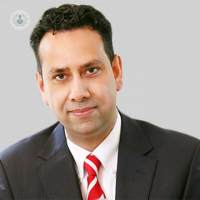Balloon kyphoplasty – a life changing procedure for spinal fractures
Autore:Mr Mo Akmal, a leading orthopaedic surgeon, explains how certain spinal fractures can be treated with balloon kyphoplasty surgery, a procedure that corrects and stabilises fractured vertebrae.
What are vertebral compression fractures?
Vertebral compression fractures are fractures of the spinal bones that are most commonly caused by minor trauma related to underlying osteoporosis or spinal metastases. The pain and deformity caused by a VCF lead to immobility, psychological depression and a loss of independence. The secondary effects of VCF are a loss of height, bowel problems, sleep disorder and dependence on strong painkillers. Even minor VCFs can cause severe pain.
Until recently, VCFs were left untreated and the fractured vertebra healed in its deformed position or did not fully heal for many months. This led to long periods of permanent pain and a hunched forward deformity of the spine known as kyphosis.

What is balloon kyphoplasty?
Balloon kyphoplasty is a percutaneous procedure performed under sedation to correct deformity and stabilise the fractured vertebra. The treated vertebra becomes strong enough to withstand any further trauma and is a permanent treatment. The majority of patients experience immediate pain relief and significant posture correction.
The procedure involves a small 3mm sized incision through which a thin tube is inserted into the fractured spinal vertebra. Under X-ray guidance, the tube is positioned into the area of bone collapse. A small balloon is inserted through the tube and carefully inflated to elevate the collapsed bone. In cases where the fracture looks suspicious for a malignancy, a biopsy of the bone can also be taken to rule out any other conditions, such as spinal metastases or bone mineral deficiency.
Once the bone collapse is corrected, the balloon is removed and the cavity is slowly injected under live X-ray with bone cement similar to that used by dentists or hip replacement surgeons. The cement fills the cavity created by the balloon and sets within a few minutes. The hardening of the cement leads to an immediate strengthening of the bone. The thin tube is then carefully removed and the entry point in the skin is sealed with a small plaster. The procedure normally takes no more than 30 minutes. Recovery from the procedure is quick and in most cases patients are fully active by two weeks.
When would balloon kyphoplasty be recommended for vertebral compression fractures?
Balloon kyphoplasty surgery is a potentially life-changing procedure and is approved by NICE (National Institute of Clinical Excellence). All patients should have an MRI scan or other diagnostic investigations prior to having balloon kyphoplasty in order to correctly identify a fracture and identify other bones that may be at the early stages of fracture so that they can also be treated at the same time.
Balloon kyphoplasty should only be performed on vertebrae that have not healed. An MRI scan is the most useful and most reliable investigation to identify a fracture that is treatable by balloon kyphoplasty. All patients should also be counselled and tested for severity of osteoporosis and undergo a screening blood test for other conditions such as secondary cancer. The procedure should only be performed by a specialist who undertakes this operation regularly and has the appropriate skills.
Are there any complications associated with balloon kyphoplasty?
The complications of balloon kyphoplasty include cement leakage into blood vessels or around nerves. Complications related to the insertion of the thin tube can also occur. The risks of complications are very low as the procedure is performed under local anaesthetic with sedation and under X-ray guidance. Long-term risks include fractures of neighbouring bones, but again, these are rare. The procedure was designated a revolution in spine surgery 15 years ago when it was still new. Nowadays, it is a routine procedure performed in thousands of elderly patients worldwide.



